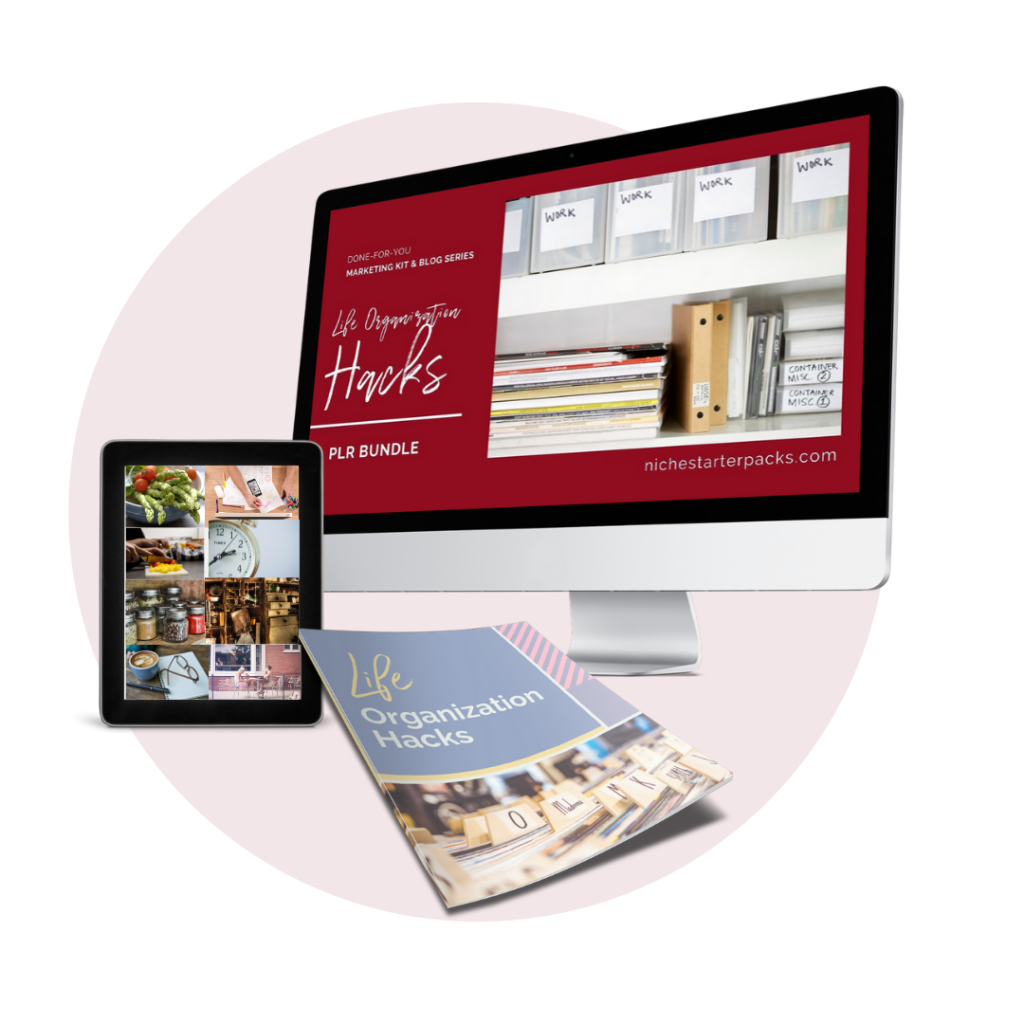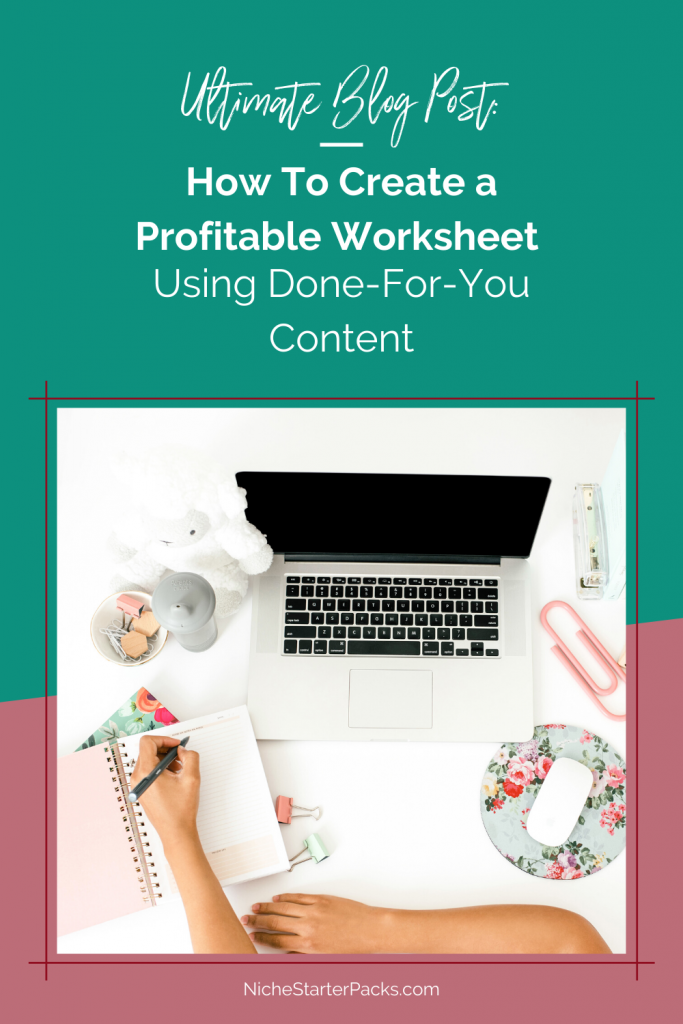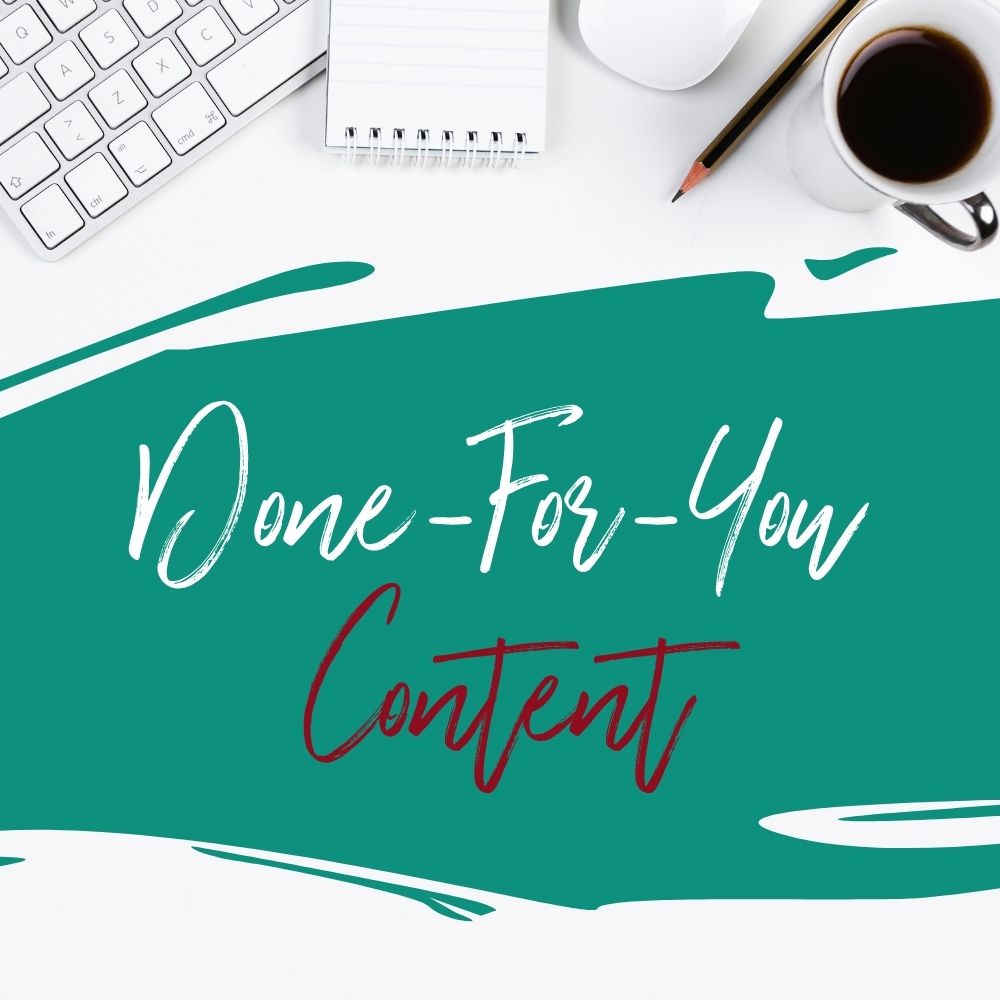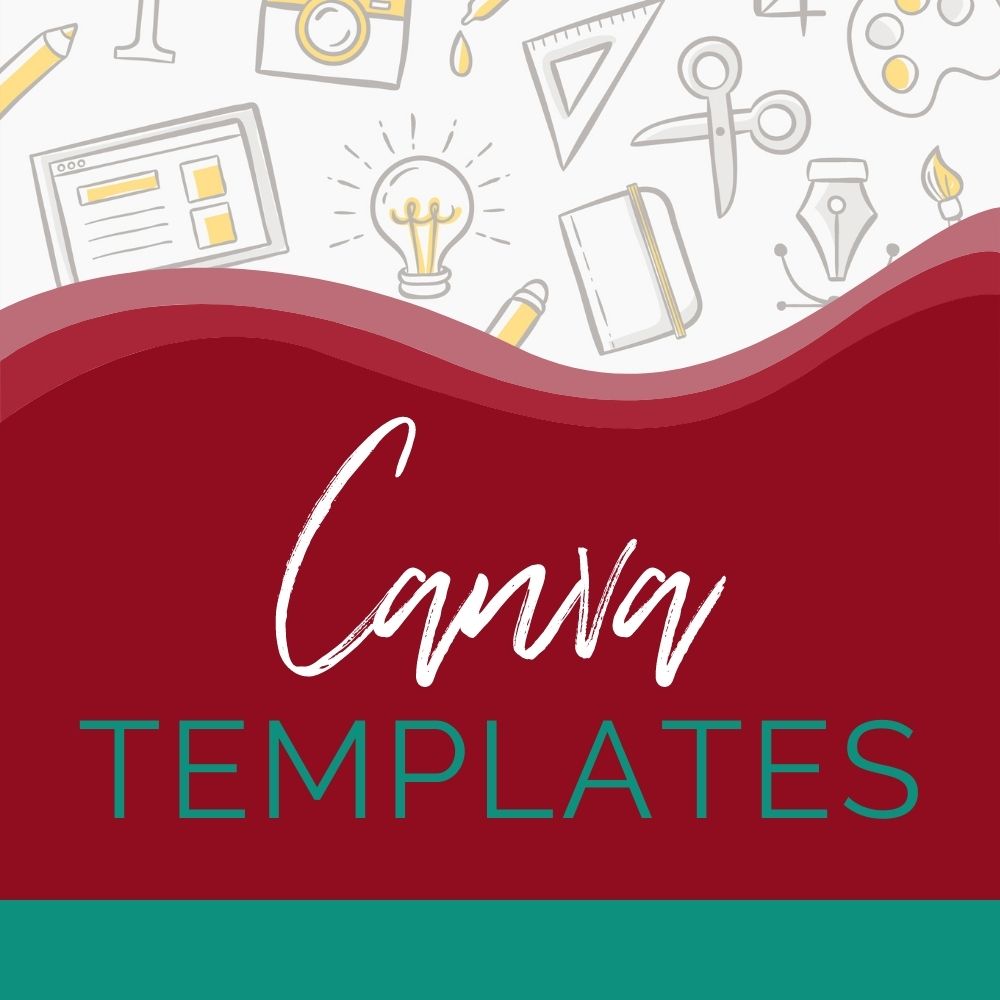Ultimate Blog Post: How To Create a Profitable Worksheet Using Done-For-You Content

Are you looking to add value to your services to keep your community happy? Offering free resources is a great way to boost audience satisfaction. One of the easiest and most effective resources you can provide is a worksheet.
Worksheets are basically templates that your customers can fill in. They can be used as a tool to help them solve any issues they may have. If you’re a coach for example, you could offer a life organization worksheet. This would help the user to become more organized in a fun and useful way.
You can create worksheets to help explain topics in depth, or to provide an actionable tool to help your community make changes in their lives. They can be surprisingly easy to put together and they provide a lot of great benefits.
However, coming up with ideas and content for your worksheets isn’t always easy. That’s where done for you content can prove invaluable.
In this ultimate blog post, you’ll learn how to create effective worksheets using done for you content. They can be an excellent opt-in you can use to provide value to your readers.
Just some of the benefits of using done for you content to create worksheets include:
Help customers identify a problem
A worksheet can get them thinking about their problem. This in turn makes it easier for you to offer a solution to that problem, potentially increasing sales.
For example, if you are a life coach, using a done for you content pack like Life Organization Hacks, you could offer a worksheet that helps people identify their bad habits. You can then offer your services to help them fix those specific habits.

Help your audience solve part of a problem
Worksheets can also be used to help solve part of a problem too. This gives them the motivation to seek help for the remaining problems they are facing.
When you offer to solve part of their problem for free, it’s going to make the reader trust you. They will appreciate the free content you’ve provided and be far more likely to want to pay for your services or products.
You can include a call to action at the bottom of the worksheet offering additional help. Again, taking the Life organization Hacks content pack as an example.
You could turn the “5 Ways to Organize Your Life” blog into a worksheet. Then, at the bottom, you could add a call to action such as “Want to get even more organized? Book a consultation today to see how I can help you organize your life”.
These are just some of the benefits a worksheet can provide. The question is, how can you create an effective worksheet using done for you content?
Read on to discover how it’s done…
Making a Worksheet
To create an effective worksheet from done for you content, you’ll need to follow three basic steps.
These include:
- Step 1: Identify your offer or objective
- Step 2: Choose a topic
- Step 3: Create your worksheet
So, let’s go ahead and break these three steps down for you…
Step 1: Identifying your offer/objective
You’re first going to need to decide which type of offer or objective you’re going to push at the end of the worksheet. This will help you to create the worksheet in a way that naturally flows to the offer.
For example…
- Are you going to offer the worksheet as a bonus at the end of an article?
- Or maybe you plan on using it to get more discovery calls?
- You could offer a free discovery call to those who download the worksheet.
- Or, are you going to sell the worksheet?
You could even create a couple of worksheets, then use a done for you content pack as an upgrade.
For example…
- Offer two worksheets providing organization tips and advice for free. Then, give the option for the customer to upgrade to your Life Organization Hacks pack. This includes a planner and worksheet alongside a whole host of other useful goodies.
Think about which type of offer would work best for your overall objective.
TIP: It’s worth doing some research here to determine which offers your audience are most interested in. That way, the worksheet will be highly effective.
After you’ve decided which type of offer you want to focus on, you can then work out the topic…

Step 2: Decide on the Topic
Now you have your offer, it’s time to focus on the topic of the worksheet. This should flow nicely into the offer you’re providing.
We can look at some examples here so you know how it works…
Example #1:
Let’s suppose you’re a life coach. You could create a worksheet that teaches potential clients about the common habits organized people share. This would give them ideas on how to become more organized following specific habits.
At the end of the worksheet, you could then offer a free discovery call. Tell the client you can work with them to discover how to develop these habits specifically for them, their situation, and challenges. A free discovery call is a way to explain how you could help with their organization habits.
This type of worksheet would offer a solution to part of the problem, while the call would potentially lead them to solve the rest of the problem.
Example #2:
You’re selling a guide to help people get out of debt using the snowball method. A worksheet could help people determine which debts to start paying off first in order to become debt-free.
The worksheet could also offer tips, such as telling them how to get the most out of the debt snowball method. You could promote the full done for you guide as a way to create and offer a more comprehensive debt management plan.
This type of worksheet focuses more on providing useful information and tools to help solve a problem. Once they have completed it, they’ll already have a basic plan put in place. The offer for the worksheet can then be focused on helping them to implement the plan or purchase a workshop that you’ve put together.
Example #3:
You’re selling coaching services. Here, you could create a worksheet that helps people determine whether or not coaching would be beneficial for them. The worksheet would uncover places where they are “stuck” in life and how a coach could help.
In the Life Organization pack, there is an excellent blog on the benefits of a more organized life. This could be turned into a worksheet which would help someone see why your services could help them.
In this example, the worksheet helps people identify if they need coaching. If they do, they can then purchase your coaching offer.
Example #4:
You’re a landscape gardener looking to gain more customers. You can create a worksheet using the Healing Gardens bundle. People are more concerned with keeping healthy today than ever before. So, showing them how to create a healing garden is going to really peak their interest.
You can then use the worksheet to offer your services at the end. Knowing how to create a healing garden is one thing, but actually putting it all together and maintaining it takes a lot of work.
So, the key to this step is to select a topic for the worksheet that gets people thinking about the next steps in their goal. Ideally, it should get them excited about the process. If you get them immersed within your worksheet, it’s going to be easy to get them to take advantage of your offer.
Take a little time to brainstorm the topics that will help your customers and clients start taking action. Decide whether it is best to create a worksheet that solves part of their problems, or one that will identify all of their problems which your product or services will then solve.
Once you’ve done this, you can move on to actually creating the worksheet.

Step 3: Develop Your Worksheet
Now you have your offer and topic firmly in mind, it’s time to create your worksheet.
There’s a lot of different elements you can include in a worksheet to make it effective. Below, we’ll look at the most common steps you can take to put a worksheet together.
As a little side note here, only the “Question” section below is absolutely necessary. The rest of the elements you can pick and choose what works best for you.
Write Down Steps
If your worksheet is going to provide more of an overview of a topic, you may find it useful to include steps that can be followed.
Each step would require the reader to answer questions or carry out a related activity.
It could be that your worksheet is teaching the reader how to organize different aspects of their life. This could include teaching them the one-minute rule for cleaning and using money management apps to organize finances.
Within each step, there should be an action the reader needs to take. For example, the money management app step would require the reader to download an app or write a list of their incomings and outgoings.
The worksheet would provide useful steps they can follow. However, these steps will only tackle part of the problem. You could then offer your coaching services at the end to help them address the real issues behind their lack of organization.
Come Up With Questions
The majority of your worksheet should focus on questions the reader has to answer to move forward.
There are two different types of questions you can ask in the sheet. These include:
- Informational questions
- Thought provoking questions
Informational style questions should be straightforward. The reader should know how to answer them without having to do additional thinking/research.
For example, if the worksheet is trying to help them become more organized, you could ask questions such as:
- “How does your morning routine typically go?”
- “What time do you get up in the morning?”
Thought-provoking questions should get the reader to think or dig deep. If you’re trying to get the reader to think more about their goals and issues.
A good example here is if you’re trying to help people get out of debt. You could ask the reader to think about their relationship with money for example. But form it into a question or a series of like….
- Did your parents talk to you about money?
- What types of words did they use when talking about money or their financial situation?
- What words do you describe money now?
- How do you feel about having money
These are questions that will dig deep and help your audience realize that how their parents felt about money and the words they use to talk about it has a huge impact on how they feel.
Other steps you can take…
Come Up With a Mini-Checklist
Mini checklists can be a great tool for the reader. You can include them in one or more of the steps you provide.
For example, if you’re putting together a worksheet that is helping the reader to become more organized, you can include a mini checklist of the tools they’ll need.
Provide a List
Lists really help the reader to ensure they have all of the right tools and information they’ll need for a task.
In the case of debt-management, a worksheet could include the different types of debts. The reader can then tick off which debts they are dealing with. This helps them to clearly see what their current debt situation is.
Make Useful Tips
You’ll find tips can be highly effective when used in a worksheet. They provide additional value to the reader, increasing their trust in you and your products.
So, taking the Life Organization Hacks content pack, you may be creating a worksheet that looks at organizational mistakes. Under each mistake, you could include a useful tip to help you avoid making that mistake again.
Using done for you content to produce your worksheet
You now know all of the elements that typically make up an effective worksheet. The question is, how can you use your done for you content to create it?
The great thing about done-for-you content is that it can be used in tons of ways. You can take bits and pieces of the blogs provided to make up the sheet and that is how you’d use PLR to create worksheets.
First read through the content to get a feel for what information is in there.
Then think which of the worksheet elements you’d like to include in your worksheet.
After that, you’re going to brainstorm the following based on what elements you want:
- Steps
- Questions
- Checklist items
- Lists
- Tips
When you’re done with these you’ll be able to start creating the worksheet that will go with the content. Take a look below of the example from one of the done-for-you content packs on Niche Starter Packs.
An Example of the Worksheet Elements Set Up
These are the main elements of a good worksheet. So, what does it look like all together?
Let’s say you’ve created a life organization tip worksheet. It may feature the following elements:
Steps
- Your worksheet would provide a number of steps the reader can take to become more organized.
- This could be practical steps such as ensuring everything has a place and waking up earlier to get more done.
Questions – Throughout the sheet you could ask questions such as:
- Which area of your life needs more organization?
- What tools do you currently use to help?
- What are the main barriers stopping you from being more organized?
Mini checklist
You could create a mini checklist of useful tools the reader can invest in to help with organizing tasks.
Lists
- You can add a list of additional resources that the reader may find useful. For example, you could link to websites or YouTube videos that look at different life organization topics.
- Watching the Marie Kondo series on Netflix
- Books on organizing your life off Amazon
- You could also create a list of areas that they want to get organized – for example, homeschooling, home routines, work, house, etc. Under each of those you could provide a checklist of what needs to be done.
Tips
As the worksheet is largely centered around tips, you’ve already got this part covered. However, you could always offer a tip alongside the lists in the worksheet. This again would provide additional value because it would give additional information on how to do something faster or better.
So, that’s what a sample worksheet could look like if you were to use all of the elements. Remember, you don’t have to use all of them and with done for you content, you’ll already have many of the elements already written.
More Ideas On How To Use Done-For-You Content
You could also create your own worksheets and then turn the content that you purchase into 30-day challenges which could be used as an upsell of the worksheet.
Or create a Facebook group dedicated to the topic covered in the worksheet and link to that.
The content provided in done for you packs can be also be used exactly how it is. So, you could simply take a full blog, like the 5 ways to organize your life, and alter it’s format a little to turn it into a ready-to use worksheet.
These are just a small number of ways you can use done for you content to put together an effective worksheet.

Making The Worksheet Profitable
After you’ve created your worksheet, it’s time to insert your offer. This is what will make the worksheet profitable for you.
You can include your offer in two main sections of the sheet. These include:
- At the very end of the worksheet
- Within the worksheet content
Generally speaking, adding your offer at the end is going to be most effective. Your worksheet is designed to lead into the offer, so placing it at the end makes the most sense.
The only time to add the offer within the worksheet content, is if you’re promoting a certain product or service to carry out one of the steps in the sheet. With the Life Organization Hacks example, you could create a worksheet on the best tools to invest in to make it easier. You could then promote your products or services under specific tools that you offer.
There are some people who choose to include their offer at the very beginning of the worksheet. The trouble with this is that the reader hasn’t yet become invested in the content. This means they aren’t desperate or even interested in fully fixing the problem just yet. So, adding it at the end is a much more effective method to use.
In terms of what makes a good offer, or call to action, it should tell the reader what you want them to do and why they should do it. A couple of examples here could be:
“Click here to book a free discovery call to find out how I can help you get more organized”
Or
“Click here to download my exclusive life organization hacks planner.”
The key thing to take away is that the worksheet needs to lead naturally to your offer. The offer you’re providing should also solve the same problem as the worksheet, only more in depth. If your offer isn’t relevant to the topic, fewer readers are going to want to take advantage of it.
For example, if your worksheet is about getting people out of debt, they aren’t going to want to take up an offer to find out how to write a sales letter. This is an extreme example, but the key to remember is that the offer HAS to be related to the topic.
Think of it as both the worksheet and the offer should provide separate value. Alone, they should provide some use to the reader, but together they provide maximum value.
TIP: When writing your call of action, try, and include a sense of urgency. You can do this by highlighting time-limited offers. Or, you could remind the reader about the disadvantages of the problem and the importance of solving it.
Never use the first call to action that pops into your head. It’s important to remember that the call to action determines the success of your opt-in. This means you should spend a little time brainstorming ideas.
Did you know you can also test your call to action? Do this by creating different copies of your worksheet. All you’ll need to make different is the call to action on each one. You’ll also need to code the links, so you know which worksheet is generating the most traffic. Include the links in emails to your subscribers and see which one performs better.
Conclusion
As you can see, a worksheet can be really useful for your audience. It can also be really profitable for you too.
Although they can take a while to create from scratch, you can save time by using done for you content. With this, you’ll simply need to alter a few paragraphs maybe, or take snippets from different content included in the pack.
One of the major advantages of worksheets is that they get the reader invested. This is half of the battle when it comes to selling products and services. As soon as they are invested in the content, they are much more likely to make a purchase.
So, if you haven’t tried it yet, why not start to put together your worksheet today? You might just be surprised by how effective they can be.
~April
P.S. Grab the Blog Series & Marketing Kit: Life Organization Hacks (or any other done-for-you pack) and create your worksheet today.
Do you want to save this for later? Pin it.




